cooling Lancia Thema 2012 Owner handbook (in English)
[x] Cancel search | Manufacturer: LANCIA, Model Year: 2012, Model line: Thema, Model: Lancia Thema 2012Pages: 316, PDF Size: 3.85 MB
Page 57 of 316

WARNING!
Do not leave children or animalsinside parked vehicles in hot
weather. Interior heat build-up
may cause serious injury or death.
It is extremely dangerous to ride in
a cargo area, inside or outside of a
vehicle. In a collision, people rid-
ing in these areas are more likely
to be seriously injured or killed.
Do not allow people to ride in any
area of your vehicle that is not
equipped with seats and seat
belts.
Be sure everyone in your vehicle is
in a seat and using a seat belt
properly.
Exhaust GasWARNING!
Exhaust gases can injure or kill.
They contain carbon monoxide
(CO), which is colorless and odor-
less. Breathing it can make you un-
conscious and can eventually poison
you. To avoid breathing (CO), fol-
low these safety tips: (Continued)
WARNING!(Continued)
Do not run the engine in a closed
garage or in confined areas any
longer than needed to move your
vehicle in or out of the area.
If you are required to drive with
the trunk/liftgate open, make sure
that all windows are closed and
the climate control BLOWER
switch is set at high speed. DO
NOT use the recirculation mode.
If it is necessary to sit in a parked
vehicle with the engine running,
adjust your heating or cooling
controls to force outside air into
the vehicle. Set the blower at high
speed.
The best protection against carbon
monoxide entry into the vehicle body
is a properly maintained engine ex-
haust system.
Whenever a change is noticed in the
sound of the exhaust system, when
exhaust fumes can be detected inside
the vehicle, or when the underside or
rear of the vehicle is damaged, have a
competent mechanic inspect the com- plete exhaust system and adjacent
body areas for broken, damaged, de-
teriorated, or mispositioned parts.
Open seams or loose connections
could permit exhaust fumes to seep
into the passenger compartment. In
addition, inspect the exhaust system
each time the vehicle is raised for lu-
brication or oil change. Replace as
required.
Safety Checks You Should
Make Inside The Vehicle
Seat Belts
Inspect the belt system periodically,
checking for cuts, frays, and loose
parts. Damaged parts must be re-
placed immediately. Do not disas-
semble or modify the system.
Front seat belt assemblies must be
replaced after a collision. Rear seat
belt assemblies must be replaced after
a collision if they have been damaged
(i.e., bent retractor, torn webbing,
etc.). If there is any question regard-
ing belt or retractor condition, replace
the belt.
51
Page 165 of 316
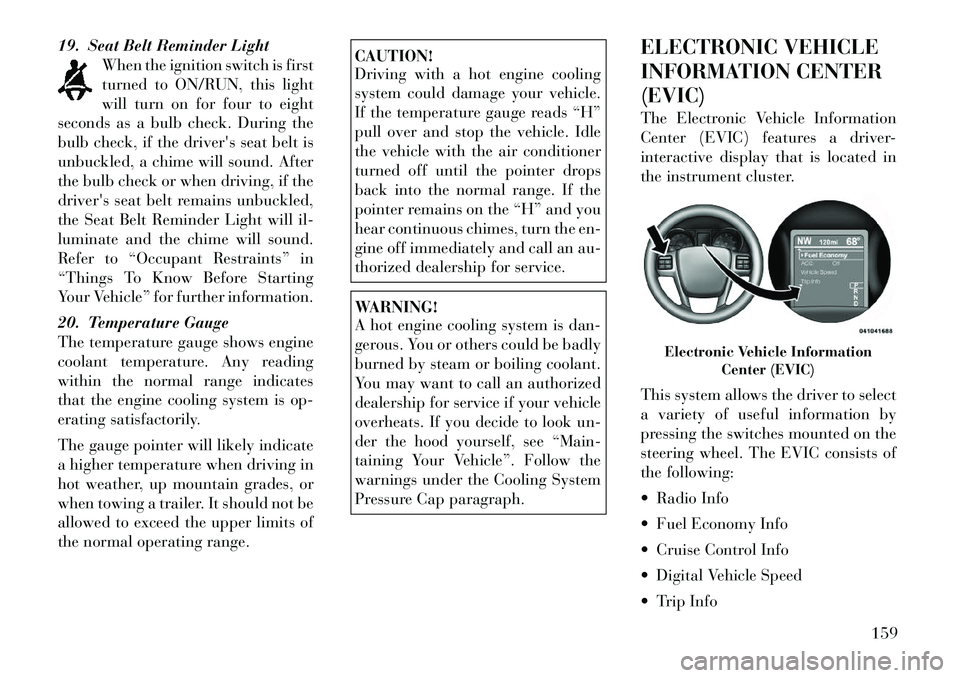
19. Seat Belt Reminder LightWhen the ignition switch is first
turned to ON/RUN, this light
will turn on for four to eight
seconds as a bulb check. During the
bulb check, if the driver's seat belt is
unbuckled, a chime will sound. After
the bulb check or when driving, if the
driver's seat belt remains unbuckled,
the Seat Belt Reminder Light will il-
luminate and the chime will sound.
Refer to “Occupant Restraints” in
“Things To Know Before Starting
Your Vehicle” for further information.
20. Temperature Gauge
The temperature gauge shows engine
coolant temperature. Any reading
within the normal range indicates
that the engine cooling system is op-
erating satisfactorily.
The gauge pointer will likely indicate
a higher temperature when driving in
hot weather, up mountain grades, or
when towing a trailer. It should not be
allowed to exceed the upper limits of
the normal operating range.
CAUTION!
Driving with a hot engine cooling
system could damage your vehicle.
If the temperature gauge reads “H”
pull over and stop the vehicle. Idle
the vehicle with the air conditioner
turned off until the pointer drops
back into the normal range. If the
pointer remains on the “H” and you
hear continuous chimes, turn the en-
gine off immediately and call an au-
thorized dealership for service.WARNING!
A hot engine cooling system is dan-
gerous. You or others could be badly
burned by steam or boiling coolant.
You may want to call an authorized
dealership for service if your vehicle
overheats. If you decide to look un-
der the hood yourself, see “Main-
taining Your Vehicle”. Follow the
warnings under the Cooling System
Pressure Cap paragraph. ELECTRONIC VEHICLE
INFORMATION CENTER
(EVIC)
The Electronic Vehicle Information
Center (EVIC) features a driver-
interactive display that is located in
the instrument cluster.
This system allows the driver to select
a variety of useful information by
pressing the switches mounted on the
steering wheel. The EVIC consists of
the following:
Radio Info
Fuel Economy Info
Cruise Control Info
Digital Vehicle Speed
Trip Info
Electronic Vehicle Information
Center (EVIC)
159
Page 189 of 316
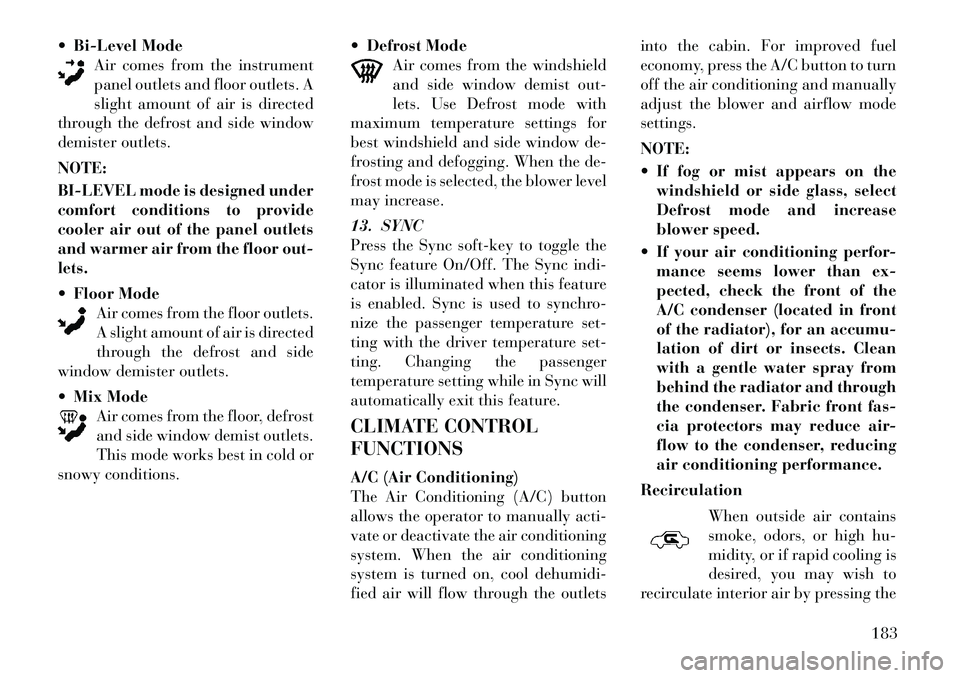
Bi-Level Mode
Air comes from the instrument
panel outlets and floor outlets. A
slight amount of air is directed
through the defrost and side window
demister outlets.
NOTE:
BI-LEVEL mode is designed under
comfort conditions to provide
cooler air out of the panel outlets
and warmer air from the floor out-
lets.
Floor Mode
Air comes from the floor outlets.
A slight amount of air is directed
through the defrost and side
window demister outlets.
Mix Mode
Air comes from the floor, defrost
and side window demist outlets.
This mode works best in cold or
snowy conditions.
Defrost Mode
Air comes from the windshield
and side window demist out-
lets. Use Defrost mode with
maximum temperature settings for
best windshield and side window de-
frosting and defogging. When the de-
frost mode is selected, the blower level
may increase.
13. SYNC
Press the Sync soft-key to toggle the
Sync feature On/Off. The Sync indi-
cator is illuminated when this feature
is enabled. Sync is used to synchro-
nize the passenger temperature set-
ting with the driver temperature set-
ting. Changing the passenger
temperature setting while in Sync will
automatically exit this feature.
CLIMATE CONTROL
FUNCTIONS
A/C (Air Conditioning)
The Air Conditioning (A/C) button
allows the operator to manually acti-
vate or deactivate the air conditioning
system. When the air conditioning
system is turned on, cool dehumidi-
fied air will flow through the outlets into the cabin. For improved fuel
economy, press the A/C button to turn
off the air conditioning and manually
adjust the blower and airflow mode
settings.
NOTE:
If fog or mist appears on the
windshield or side glass, select
Defrost mode and increase
blower speed.
If your air conditioning perfor- mance seems lower than ex-
pected, check the front of the
A/C condenser (located in front
of the radiator), for an accumu-
lation of dirt or insects. Clean
with a gentle water spray from
behind the radiator and through
the condenser. Fabric front fas-
cia protectors may reduce air-
flow to the condenser, reducing
air conditioning performance.
Recirculation When outside air contains
smoke, odors, or high hu-
midity, or if rapid cooling is
desired, you may wish to
recirculate interior air by pressing the
183
Page 191 of 316
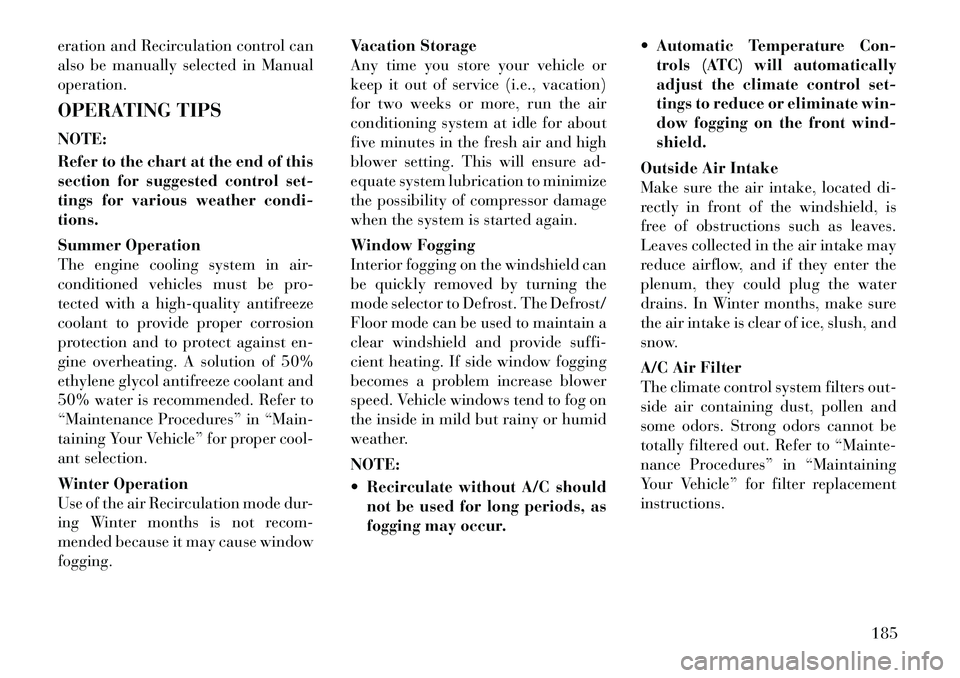
eration and Recirculation control can
also be manually selected in Manual
operation.
OPERATING TIPS
NOTE:
Refer to the chart at the end of this
section for suggested control set-
tings for various weather condi-
tions.
Summer Operation
The engine cooling system in air-
conditioned vehicles must be pro-
tected with a high-quality antifreeze
coolant to provide proper corrosion
protection and to protect against en-
gine overheating. A solution of 50%
ethylene glycol antifreeze coolant and
50% water is recommended. Refer to
“Maintenance Procedures” in “Main-
taining Your Vehicle” for proper cool-
ant selection.
Winter Operation
Use of the air Recirculation mode dur-
ing Winter months is not recom-
mended because it may cause window
fogging.Vacation Storage
Any time you store your vehicle or
keep it out of service (i.e., vacation)
for two weeks or more, run the air
conditioning system at idle for about
five minutes in the fresh air and high
blower setting. This will ensure ad-
equate system lubrication to minimize
the possibility of compressor damage
when the system is started again.
Window Fogging
Interior fogging on the windshield can
be quickly removed by turning the
mode selector to Defrost. The Defrost/
Floor mode can be used to maintain a
clear windshield and provide suffi-
cient heating. If side window fogging
becomes a problem increase blower
speed. Vehicle windows tend to fog on
the inside in mild but rainy or humid
weather.
NOTE:
Recirculate without A/C should
not be used for long periods, as
fogging may occur. Automatic Temperature Con-
trols (ATC) will automatically
adjust the climate control set-
tings to reduce or eliminate win-
dow fogging on the front wind-
shield.
Outside Air Intake
Make sure the air intake, located di-
rectly in front of the windshield, is
free of obstructions such as leaves.
Leaves collected in the air intake may
reduce airflow, and if they enter the
plenum, they could plug the water
drains. In Winter months, make sure
the air intake is clear of ice, slush, and
snow.
A/C Air Filter
The climate control system filters out-
side air containing dust, pollen and
some odors. Strong odors cannot be
totally filtered out. Refer to “Mainte-
nance Procedures” in “Maintaining
Your Vehicle” for filter replacement
instructions.
185
Page 242 of 316
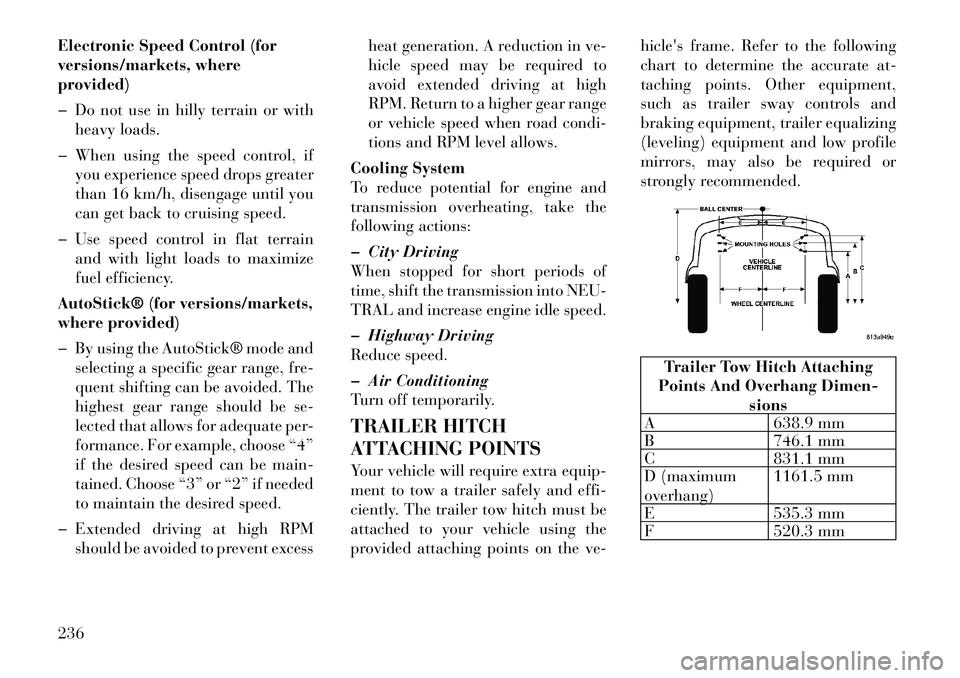
Electronic Speed Control (for
versions/markets, where
provided)
� Do not use in hilly terrain or withheavy loads.
� When using the speed control, if you experience speed drops greater
than 16 km/h, disengage until you
can get back to cruising speed.
� Use speed control in flat terrain and with light loads to maximize
fuel efficiency.
AutoStick® (for versions/markets,
where provided)
� By using the AutoStick® mode and selecting a specific gear range, fr e-
quent shifting can be avoided. The
highest gear range should be se-
lected that allows for adequate per-
formance. For example, choose “4”
if the desired speed can be main-
tained. Choose “3” or “2” if needed
to maintain the desired speed.
� Extended driving at high RPM should be avoided to prevent excess heat generation. A reduction in
ve-
hicle speed may be required to
avoid extended driving at high
RPM. Return to a higher gear range
or vehicle speed when road condi-
tions and RPM level allows.
Cooling System
To reduce potential for engine and
transmission overheating, take the
following actions:
� City Driving
When stopped for short periods of
time, shift the transmission into NEU-
TRAL and increase engine idle speed.
� Highway Driving
Reduce speed.
� Air Conditioning
Turn off temporarily.
TRAILER HITCH
ATTACHING POINTS
Your vehicle will require extra equip-
ment to tow a trailer safely and effi-
ciently. The trailer tow hitch must be
attached to your vehicle using the
provided attaching points on the ve- hicle's frame. Refer to the following
chart to determine the accurate
at-
taching points. Other equipment,
such as trailer sway controls and
braking equipment, trailer equalizing
(leveling) equipment and low profile
mirrors, may also be required or
strongly recommended.
Trailer Tow Hitch Attaching
Points And Overhang Dimen- sions
A 638.9 mm
B 746.1 mm
C 831.1 mm
D (maximum
overhang) 1161.5 mm
E 535.3 mm
F 520.3 mm
236
Page 246 of 316
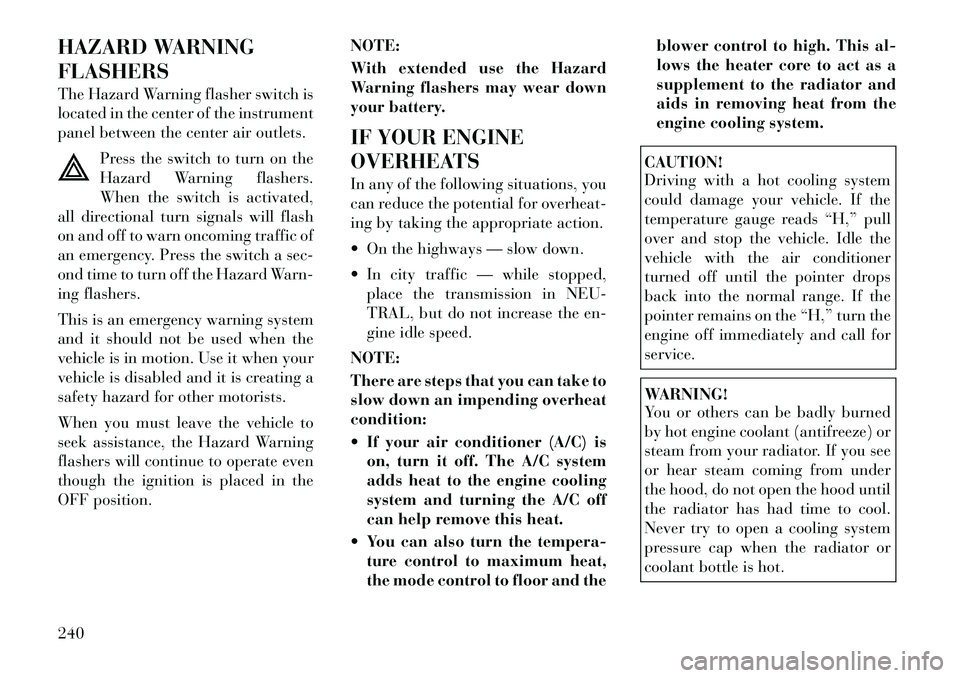
HAZARD WARNING
FLASHERS
The Hazard Warning flasher switch is
located in the center of the instrument
panel between the center air outlets.Press the switch to turn on the
Hazard Warning flashers.
When the switch is activated,
all directional turn signals will flash
on and off to warn oncoming traffic of
an emergency. Press the switch a sec-
ond time to turn off the Hazard Warn-
ing flashers.
This is an emergency warning system
and it should not be used when the
vehicle is in motion. Use it when your
vehicle is disabled and it is creating a
safety hazard for other motorists.
When you must leave the vehicle to
seek assistance, the Hazard Warning
flashers will continue to operate even
though the ignition is placed in the
OFF position. NOTE:
With extended use the Hazard
Warning flashers may wear down
your battery.
IF YOUR ENGINE
OVERHEATS
In any of the following situations, you
can reduce the potential for overheat-
ing by taking the appropriate action.
On the highways — slow down.
In city traffic — while stopped,
place the transmission in NEU-
TRAL, but do not increase the en-
gine idle speed.
NOTE:
There are steps that you can take to
slow down an impending overheat
condition:
If your air conditioner (A/C) is on, turn it off. The A/C system
adds heat to the engine cooling
system and turning the A/C off
can help remove this heat.
You can also turn the tempera- ture control to maximum heat,
the mode control to floor and the blower control to high. This al-
lows the heater core to act as a
supplement to the radiator and
aids in removing heat from the
engine cooling system.
CAUTION!
Driving with a hot cooling system
could damage your vehicle. If the
temperature gauge reads “H,” pull
over and stop the vehicle. Idle the
vehicle with the air conditioner
turned off until the pointer drops
back into the normal range. If the
pointer remains on the “H,” turn the
engine off immediately and call for
service.WARNING!
You or others can be badly burned
by hot engine coolant (antifreeze) or
steam from your radiator. If you see
or hear steam coming from under
the hood, do not open the hood until
the radiator has had time to cool.
Never try to open a cooling system
pressure cap when the radiator or
coolant bottle is hot.
240
Page 253 of 316

Remote Battery PostsWARNING!
Take care to avoid the radiatorcooling fan whenever the hood is
raised. It can start anytime the
ignition switch is on. You can be
injured by moving fan blades.
Remove any metal jewelry such as
watch bands or bracelets that
might make an inadvertent elec-
trical contact. You could be seri-
ously injured.
Batteries contain sulfuric acid
that can burn your skin or eyes
and generate hydrogen gas which
is flammable and explosive. Keep
open flames or sparks away from
the battery. 1. Set the parking brake, shift the
automatic transmission into PARK
and turn the ignition to LOCK.
2. Turn off the heater, radio, and all
unnecessary electrical accessories.
3. If using another vehicle to jump-
start the battery, park the vehicle
within the jumper cables reach, set
the parking brake and make sure the
ignition is OFF.
WARNING!
Do not allow vehicles to touch each
other as this could establish a
ground connection and personal in-
jury could result.
JUMP-STARTING
PROCEDUREWARNING!
Failure to follow this procedure
could result in personal injury or
property damage due to battery ex-
plosion.
CAUTION!
Failure to follow these procedures
could result in damage to the charg-
ing system of the booster vehicle or
the discharged vehicle.
1. Connect the positive (+)end of the
jumper cable to the remote positive
(+) post of the discharged vehicle.
2. Connect the opposite end of the
positive (+)jumper cable to the posi-
tive (+)post of the booster battery.
3. Connect the negative end (-)of the
jumper cable to the negative (-)post
of the booster battery.
4. Connect the opposite end of the
negative (-)jumper cable to the re-
mote negative (-)post of the vehicle
with the discharged battery.WARNING!
Do not connect the cable to the nega-
tive post (-)of the discharged bat-
tery. The resulting electrical spark
could cause the battery to explode
and could result in personal injury.
1 — Remote Positive (+) Post
2 — Remote Negative (-) Post
247
Page 260 of 316
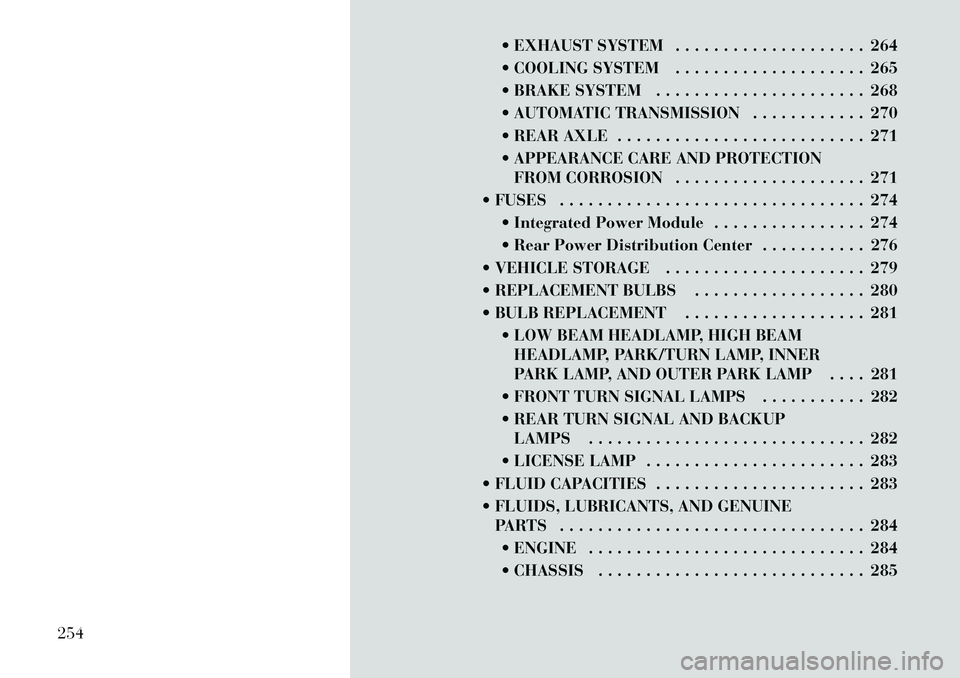
EXHAUST SYSTEM . . . . . . . . . . . . . . . . . . . . 264
COOLING SYSTEM . . . . . . . . . . . . . . . . . . . . 265
BRAKE SYSTEM . . . . . . . . . . . . . . . . . . . . . . 268
AUTOMATIC TRANSMISSION . . . . . . . . . . . . 270
REAR AXLE . . . . . . . . . . . . . . . . . . . . . . . . . . 271
APPEARANCE CARE AND PROTECTIONFROM CORROSION . . . . . . . . . . . . . . . . . . . . 271
FUSES . . . . . . . . . . . . . . . . . . . . . . . . . . . . . . . . 274 Integrated Power Module . . . . . . . . . . . . . . . . 274
Rear Power Distribution Center . . . . . . . . . . . 276
VEHICLE STORAGE . . . . . . . . . . . . . . . . . . . . . 279
REPLACEMENT BULBS . . . . . . . . . . . . . . . . . . 280
BULB REPLACEMENT . . . . . . . . . . . . . . . . . . . 281 LOW BEAM HEADLAMP, HIGH BEAMHEADLAMP, PARK/TURN LAMP, INNER
PARK LAMP, AND OUTER PARK LAMP . . . . 281
FRONT TURN SIGNAL LAMPS . . . . . . . . . . . 282
REAR TURN SIGNAL AND BACKUP LAMPS . . . . . . . . . . . . . . . . . . . . . . . . . . . . . 282
LICENSE LAMP . . . . . . . . . . . . . . . . . . . . . . . 283
FLUID CAPACITIES . . . . . . . . . . . . . . . . . . . . . . 283
FLUIDS, LUBRICANTS, AND GENUINE PARTS . . . . . . . . . . . . . . . . . . . . . . . . . . . . . . . . 284
ENGINE . . . . . . . . . . . . . . . . . . . . . . . . . . . . . 284
CHASSIS . . . . . . . . . . . . . . . . . . . . . . . . . . . . 285
254
Page 271 of 316

NOTE:
Intentional tampering with emis-
sions control systems can result in
civil penalties being assessed
against you.WARNING!
A hot exhaust system can start a fire
if you park over materials that can
burn. Such materials might be grass
or leaves coming into contact with
your exhaust system. Do not park or
operate your vehicle in areas where
your exhaust system can contact
anything that can burn.
In unusual situations involving
grossly malfunctioning engine opera-
tion, a scorching odor may indicate
severe and abnormal catalyst over-
heating. If this should occur, safely
bring the vehicle to a complete stop,
shut the engine OFF, and allow the
vehicle to cool. Thereafter, obtain ser-
vice, including a tune-up to manufac-
tur er's specifications immediately.
To minimize the possibility of catalyst
damage: Do not shut off the engine or inter
-
rupt the ignition when the trans-
mission is in gear and the vehicle is
in motion.
Do not try to start the engine by pushing or towing the vehicle.
Do not idle the engine with any spark plug wires disconnected or
removed, such as when diagnostic
testing, or for prolonged periods
during very rough idling or mal-
functioning operating conditions.
COOLING SYSTEM
WARNING!
When working near the radiator cooling fan, disconnect the fan
motor lead or turn the ignition
switch to the LOCK position . The
fan is temperature controlled and
can start at any time the ignition
switch is in the ON position.
(Continued)
WARNING!(Continued)
You or others can be badly burned
by hot engine coolant (antifreeze)
or steam from your radiator. If
you see or hear steam coming
from under the hood, do not open
the hood until the radiator has
had time to cool. Never try to open
a cooling system pressure cap
when the radiator is hot.CAUTION!
Car maintenance should be done at
a LANCIA Dealership. For routine
and minor maintenance operations
you wish to carry out yourself, we do
recommend you have the proper
equipment, genuine LANCIA spare
parts and the necessary fluids; do
not however carry out these opera-
tions if you have no experience.
Coolant Checks
Check engine coolant (antifreeze)
protection every 12 months (before
the onset of freezing weather, where
applicable). If the engine coolant (an-
tifreeze) is dirty or rusty in appear-
ance, the system should be drained,
265
Page 272 of 316

flushed, and refilled with fresh cool-
ant. Check the front of the A/C con-
denser for any accumulation of bugs,
leaves, etc. If dirty, clean by gently
spraying water from a garden hose
vertically down the face of the con-
denser.
Check the coolant recovery bottle
tubing for brittle rubber, cracking,
tears, cuts, and tightness of the con-
nection at the bottle and radiator. In-
spect the entire system for leaks.
With the engine at normal operating
temperature (but not running), check
the cooling system pressure cap for
proper vacuum sealing by draining a
small amount of engine coolant (anti-
freeze) from the radiator drain cock.
If the cap is sealing properly, the en-
gine coolant (antifreeze) will begin to
drain from the coolant recovery
bottle. DO NOT REMOVE THE
COOLANT PRESSURE CAP WHEN
THE COOLING SYSTEM IS HOT.
Cooling System – Drain, Flush,
And Refill
If the engine coolant (antifreeze) is
dirty or contains a considerableamount of sediment, clean and flush
with a reliable cooling system cleaner.
Follow with a thorough rinsing to re-
move all deposits and chemicals.
Properly dispose of the old engine
coolant (antifreeze) solution.
Refer to the “Maintenance Schedule”
for the proper maintenance intervals.
Selection Of Coolant
Use only the manufactur
er's recom-
mended engine coolant (antifreeze).
Refer to “Fluids, Lubricants, and
Genuine Parts” in “Maintaining Your
Vehicle” for further information.
CAUTION!
Mixing of engine coolant (anti- freeze) other than specified engine
coolant (antifreeze), may result in
engine damage and may decrease
corrosion protection. If a non-
specified engine coolant (anti-
freeze) is introduced into the cool-
ing system in an emergency, it
should be replaced with the speci-
fied engine coolant (antifreeze) as
soon as possible.
(Continued)
CAUTION!(Continued)
Do not use water alone or alcohol-
based engine coolant (antifreeze)
products. Do not use additional
rust inhibitors or antirust prod-
ucts, as they may not be compat-
ible with the radiator engine cool-
ant (antifreeze) and may plug the
radiator.
This vehicle has not been de-
signed for use with propylene
glycol-based engine coolant (anti-
freeze). Use of propylene glycol-
based engine coolant (antifreeze)
is not recommended.
Adding Coolant
Your vehicle has been built with an
improved engine coolant (antifreeze)
that allows extended maintenance in-
tervals. This engine coolant (anti-
freeze) can be used up to five years or
168 000 km before replacement. To
prevent reducing this extended main-
tenance period, it is important that
you use the same engine coolant (an-
tifreeze) throughout the life of your
vehicle.
266